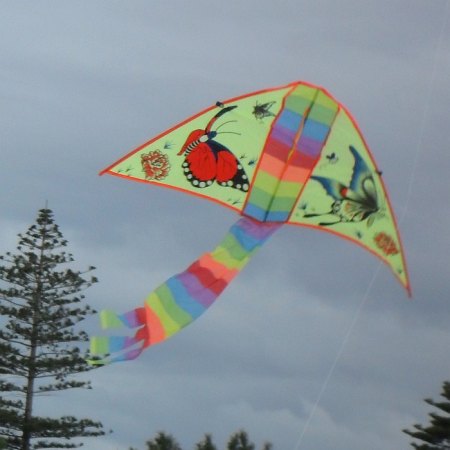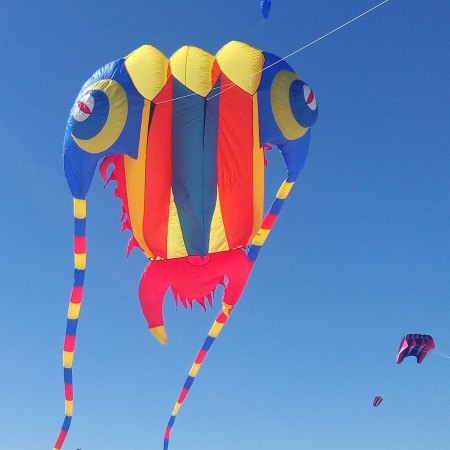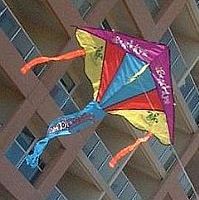- Home Page
- Accessories
- Nylon Kites
Ripstop Nylon Kites
An Ideal Sail Fabric
In this look at ripstop-nylon kites, I'm focusing on what the fabric is and it's various uses—particularly for kites, of course, as illustrated in the photos.
These days, nylon kite-sail material is dyed in the factory. It's not painted. Hence many bright colors are available straight "off the shelf." However, it's still possible to home-dye plain ripstop-nylon cloth. Some have even done a tie-dye job on their kite sail! Ah, the 70s.
Dye products from the Dylon company can be used to successfully and permanently change the color of the fabric. The process involves soaking the cloth in a hot (but not boiling) dye solution. Very thorough rinsing with cold water afterward is necessary. Otherwise, any dye left on the surface could start to run if the kite gets wet! That would be OK (I guess) if all the panels are the same color, but otherwise it could really be a disaster.
On this site, there's more kite-making info than you can poke a stick at. :-)
Want to know the most convenient way of using it all?
The Big MBK E-book Bundle is a collection of downloads—printable PDF files which provide step-by-step instructions for many kites large and small.
Every kite in every MBK series.
I've had positive feedback from visitors who have re-made some of my MBK plastic-sailed designs in ripstop. That includes a guy who scaled up the MBK Octopus so it was many meters in length. He sent through some in-flight photos as proof!
On the topic of making homemade kites, check out this video with a rather cool soundtrack, featuring a neat little delta. The guy later added a drogue for extra stability—also in ripstop, of course.
Here are a couple of photos we took at the Adelaide Kite Festival some years ago, representing the small and
big end of the retail-kite spectrum. I'm pretty sure they both employed
ripstop nylon fabric! There's a small cheap delta in the first image and a much larger—and pricier—show kite in the other image:
 Small cheap kids' delta
Small cheap kids' delta Large expensive trilobyte show kite!
Large expensive trilobyte show kite!Just to digress for a moment, not all homemade kites are made in ripstop straight away. A useful approach is to make a kite in plastic first, just to get a feel for its performance and general flying characteristics.
When the owner is satisfied, perhaps after making more than one kite, they splash out on some colored fabric and make the long-lasting ripstop-nylon kite of their dreams. :-)
The World of Ripstop
 Typical ripstop nylon kite
Typical ripstop nylon kiteBy the way, it's not limited to nylon, but let's stick to the topic at hand.
Nylon itself is used in a massive array of everyday items, so I won't even mention any here. You can probably think of a quite a few yourself without doing any research at all!
Even the ripstop variety of nylon cloth has many, many uses in the 21st century. This is not common knowledge, so I will list a few here:
- Outdoor gear such as tents and weatherproof covers.
- Colorful, lightweight, and durable clothing. Also, accessories such as bags.
- Engineless aviation sectors such as balloons, hang-gliders, paragliders, and parasails.
- KITES! Thank goodness for that. There's a colorful delta we once had, in the photo.
As far as history goes, there's not much to be found online—apart
from the fact that this material replaced silk as the cloth of choice
for military parachutes. That was back during World War 2 in the 1940s. Being
synthetic, it was easy to produce nylon fabric in large volumes, and thus
production was cheap compared to using silk.
Ripstop. That's quite descriptive, because larger diameter threads are woven into the fabric at regular intervals—typically 5 to 8 milllmeters (1/5 to 1/4 inch). This results in a pattern of small squares, which are visible if you look at the material closely. Any small hole or tear tends to stop at the first larger thread it comes to. The rip stops.
There wouldn't be much left if you took all the ripstop nylon fabric away from a typical kite festival!
In a nutshell, this kite sail material is very light and very durable. Also, it is made with zero porosity, which means air and water cannot penetrate it. It's almost like it was made for kites in the first place!
For some other applications, the porosity is not zero. Enough said.
A Word on Weights
The great majority of ripstop-nylon kites in shops these days seem to use either 1/2 ounce or 3/4-ounce material. That's the weight per square yard of material. 1.5 ounce is less common, and there is even a smattering of other odd sizes like 0.6 ounce.
Hang on, why "square yards" in this metric age? To get more precise about it, in the USA they use ounces per "sailmaker's yard" which is 36 by 28.5 inches. The Brits use the standard Imperial yard. Finally, and most sensibly, the rest of Europe uses grams per square meter.
One ounce American equals 1.26 ounces British and 42.8 grams per square meter. So when you buy a kite, the meaning of the cloth weight figure (if given) depends on the country of manufacture of the ripstop cloth.
We saw a Cody box kite once at a kite festival, aloft in a very light breeze. Huh? Well, it was covered in 1/2-ounce ripstop nylon, apparently, and I'm guessing it had graphite spars as well! Box kites ain't what they used to be but in a positive way.
Perhaps the massive kite-selling activity in the USA is the reason this non-metric measure seems to persist when people talk and write about sail weight.
Personally, I've bypassed using ripstop altogether, since I'm all about showing people how to make their own kites quickly from cheap materials.
I guess if a plastic creation really "hits the spot" then it can be re-made in ripstop nylon and attached to the frame with nylon repair tape. It would then be a tad heavier but definitely more durable.
As mentioned earlier, there's more kite making on this site than you can poke a stick at. :-)
Want to know the most convenient way of using it all?
The Big MBK E-book Bundle is a collection of downloads—printable PDF files that provide step-by-step instructions for many kites large and small.
That's every kite in every MBK series.
